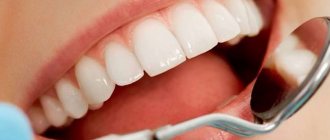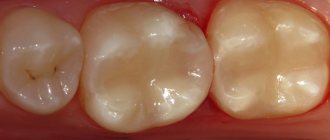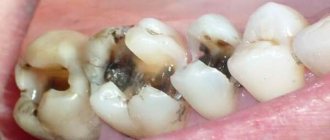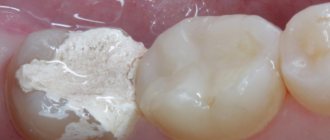Modern people do not visit the dentist as often as recommended. Usually a visit is associated with severe pain, when it is no longer possible to endure. Because of this, most patients are unaware of innovations in the world of medicine.
For many of us, a filling made of composite materials is the only option to plug a hole in a tooth. Few people know about the existence of ceramic and plastic fillings, not to mention advanced light fillings. Let's find out what a light filling is, the features of the most advanced fillings at the moment, and what their price consists of.
Features of installing light seals
An ordinary composite chemical filling, which is placed in any clinic, is distinguished by its affordable price and fragility. It hardens quickly as a result of mixing chemical components. There is no need to talk about the aesthetics of such a filling. It does not have a variety of colors and cannot be sanded in detail after installation.
The light filling hardens under the influence of ultraviolet radiation, until this moment the filling remains plastic . The dentist has no time limit to perfectly form a filling for a damaged tooth. Recreating the correct tooth shape is only possible with a light filling.
A photopolymer filling consists of a main filler and a substance susceptible to UV light. When exposed to ultraviolet radiation, two processes occur simultaneously: hardening of the filling and color polymerization.
The filling of the filling is chosen depending on the task at hand. For molars, whose main task is to chew food, fillers with large and coarse particles are intended. They don't look as nice, but they last longer.
For incisors (front teeth), aesthetics is much more important. These teeth come into contact with food only during a bite, so fillers with fine dust-like contents are intended for them.
Popular questions
What to do if the filling composition has changed color (darkened, yellowed, blackened)? How to bleach?
The filling composition changes its color over time, just like tooth enamel. However, it is less susceptible to whitening with pastes and gels. Therefore, it is best to go to the clinic so that the doctor will bleach the filling using professional means or remove some material from the surface and replace it with a new one.
Is the filling visible after treatment?
With modern equipment and materials, photopolymers do not stand out in any way against the background of the dental surface of a molar.
What should you do if the filling on your front tooth falls out, peels off, or breaks off?
In this case, you need to make an appointment with the dentist for re-treatment. If the chip is small, the therapist will only sand it a little so that it does not deteriorate further and does not scratch the tongue. If a large part falls off or falls out completely, you will have to replace it entirely.
What to do if it was placed ugly?
Aesthetics is one of the important components of dental therapy. The patient has the right to demand re-treatment from the clinic administration.
What is a temporary filling for front teeth?
A temporary structure is placed for long-term treatment, which requires several sessions of visiting the dentist. Such a filling is needed to prevent food debris from packing into the opened cavity and for the patient’s convenience.
What is a bite filling for anterior teeth?
This is also a temporary analogue, only larger in size. It is necessary to wear it when wearing braces, so that when closing the chewing organs do not disturb the structure and do not deform it. Also, a bite filling is used for severe chips during long-term dental treatment.
Is it possible to build up a front tooth with a filling?
Modern filling compositions are designed not only for filling carious cavities, but also for restoration after chips. At the same time, the strength of the extended molar will allow you to bite and chew food normally.
What is better – a filling or a veneer?
Both technologies have pros and cons. In particular, veneers have better aesthetic properties and plaque does not settle on them, while filling takes less time and the filling lasts longer.
Before and after installing fillings on the front teeth
How much does a light filling cost and why?
The cost of a light seal puts off many patients until they learn the real benefits of this approach. Prices for such fillings in different clinics range from 500 to 1000 rubles. But this is not the limit, because additional work is paid separately. As a result, the amount can grow to several thousand rubles for one filling.
What the patient pays for:
- Anesthesia if necessary (cheap or expensive, public clinics also offer free anesthesia)
- Removal of damaged tissue
- Cleaning the tooth before filling
- Polymer matrix
- Main filler (Silicon dioxide or glass ceramics)
- Binder
The clinic uses imported components for light fillings. The main suppliers are: USA, Japan and Germany. Analogues are being developed in Russia, but so far they are not on the market. The cost of the filling also depends on the country of origin. The quality of the composites is at a high level.
We advise you to find out in advance how much you will have to pay for each cycle of work. It’s better to choose a “turnkey” filling with anesthesia and x-rays for a certain price than to then quarrel with the administration and find out the reasons for the high bill.
What you should pay attention to when choosing fillings
In order for the filling to be successful and the result to last for a long time, it is necessary to take a responsible approach to selecting the appropriate type of product. Many patients are confused when they learn how many varieties there are. What criteria should be taken into account when choosing a filling material:
- strength and wear resistance;
- environmental friendliness;
- safety for the body;
- hardening in minimal time;
- tightness, flexibility when grinding;
- maintaining the original shade throughout its service life.
In addition, the manufacturer plays an important role. Professional doctors prefer Israeli, German and other European brands because they produce high-quality products that are absolutely safe and meet other requirements. Such accessories last a long time, they are reliable and strong. A negative point is the higher price compared to domestic analogues, but for many this will not seem like a minus.
Stages of installing a seal
Installing a light seal is a lengthy process, but the result is worth it. The patient receives not just a patch for the tooth, he receives an almost new tooth with artificial filling. This step does not include pain relief because it is only used when necessary.
- First, the dentist examines the damaged tooth, removes damaged tissue, and disinfects the internal and external surfaces of the tooth. If necessary, grinds a hole to the required diameter
- Once all the preparatory work has been completed, the doctor dries the surface of the tooth so that saliva does not remain under the layers of the filling.
- A light-sensitive polymer is placed into the resulting cavity layer by layer. Each layer is dried until hardened, after which a new one is applied
- The very last top layer requires special attention. The dentist’s task is to recreate the surface in such a way that the tooth is reconstructed to its original state
- Before exposing the final layer to ultraviolet light, the dentist checks the interaction of the tooth with the opposing teeth. The bite should not change
- After the filling has hardened under exposure to light, it is ground and polished to resemble a natural tooth.
- The final stage will be an x-ray of the tooth to make sure there is no air and moisture in the dental cavity. Typically, this service is paid additionally
Life time
The service life of photopolymer fillings largely depends on the quality of the material and the competence of the specialist. In addition, the patient himself is able to both shorten and significantly extend the service life of the filling.
The materials used in the filling process can be either highly durable or less reliable. Provided that a high-quality composite is used, it can last up to seven years.
There are cases when the filling falls out almost immediately after its installation. There may be several reasons for this. It is possible that when filling, the doctor made a mistake, as a result of which the material was not securely fixed. The most common cause is adhesion failure due to saliva or liquid.
Filling falling out
Dental treatment often takes a long time.
In such cases a guarantee is issued. Within a year after the filling is installed, the patient can apply for a repeat procedure. There is no charge for the service.
It is also possible that the patient simply did not follow all medical recommendations. In this case, you also need to seek help from a specialist. It is advisable to give preference to those clinics that have only positive recommendations. In this case, the risk of the filling falling out will be minimal.
Light fillings on front teeth
When it comes to the aesthetics of the oral cavity, all dentists recommend installing a light filling. No other is able to fit into the dentition in such a way that there are no differences.
The light-curing filling has a large number of colors and shades. Once you have decided to have it placed, your dentist will select the shade of the filling based on the color of your tooth. This is a critical moment for the front teeth. The boundaries of the light seal are almost impossible to see.
What is a tab
Veneers are used to restore the beauty of the front teeth and strengthen them.
Stump tab
used to strengthen molars. More often it is a mini-prosthesis that completely repeats the shape of the internal destroyed part of the crown. It is inserted into the tooth and secured with a special dental compound.
Such structures are a good way to restore a tooth. The inlay is used when the destruction of the natural crown exceeds 30% and there is a healthy root.
Their service life is 20 years or more, the materials tolerate chewing loads and correspond to the anatomical structure of the tooth. Their shade remains unchanged under the influence of food coloring. There are options:
- Restorative
, their role is close to the function of a filling. They are attached to the top of the unit without touching the channels. - Stump mini-prostheses
. Such a frame is fixed in the channel. Then the tooth is covered with a crown. A post-core inlay can help if the visible part of the tooth has crumbled and only the root remains.
Metal-free tab
– restoration of the dental crown, which is orthopedically justified and aesthetically pleasing. The surface wears out synchronously with the enamel, without any discomfort.
Advantages and disadvantages
There is nothing better than a natural healthy tooth. Therefore, any dental intervention will have its pros and cons. A light filling certainly has more advantages.
Advantages
- High plasticity of the filling for an unlimited time, which makes it ideal. The material will not harden at the most inopportune moment
- Safety for the patient, no side effects. The filling can be placed on children and pregnant women. No toxins
- A large color palette from which the doctor can select a color that is indistinguishable from the natural tooth of each individual person
- Durability
- A correctly formed filling does not cause any discomfort to the wearer.
- A light-curing filling can restore a tooth, even if more than half of the bone tissue is destroyed
- Almost instant bonding with the tooth. After an hour you can already consume food in most cases
Flaws
- The first and main disadvantage is the high cost. Of course, it is not formed out of thin air; you will definitely be pleased with the result. But a fact is a fact
- The light seal cannot be placed in hard-to-reach places. Such fillings do not cover external cervical caries of “sevens” and “eights,” for example. Because the ultraviolet lamp will not be able to illuminate the surface of the tooth, and the filling will not harden properly
- For several days, you should not consume food or drinks that are coloring, so that the filling does not change its color.
- Over time, the color may change and move away from ideal similarity due to incomplete polymerization
Restoring teeth using root veneers
In orthopedics, there are unique possibilities for restoring teeth in cases where only one root remains of a tooth. You must immediately understand that the root tissue of the teeth must be healthy - this is the main condition for 100% tooth restoration. Look at the photo to see what we are talking about - caries-affected tissues are removed and ground down to healthy tooth tissues:
In such cases, veneers with the root part
:
And this is how beautifully, and most importantly, you can reliably restore your teeth:
Patients who encounter such technologies for the first time experience a wow effect, and their smile is not only restored, but becomes incredibly beautiful:
By the way, this clinical example can be viewed in more detail HERE.
How long after a light filling can I eat?
Dentists recommend not eating for exactly one hour after you leave the office with a new tooth. Much depends on what size filling is installed and what percentage of the tooth was initially damaged.
- If a filling is placed in a tooth with a small hole, that is, it can be done immediately after installation, there are no restrictions. True, such situations rarely happen.
- If the tooth damage was moderate, then it will be enough to refuse food for an hour
- If the tooth has been restored, if there is now more filling material on it than bone tissue, then refrain from eating for 2-3 hours. After three hours of waiting, you can definitely eat no matter how much dental work you do.
If the seal falls out or is damaged
If there is any deformation of the light filling, no action should be taken without first consulting a doctor. If it is not possible to visit the clinic, you can get a consultation by phone. But at the first opportunity, go to the dentist.
If there is a filling, it is important to prevent food particles from entering the tooth cavity. This can lead to inflammation and even the rapid development of a purulent process.
To summarize, we can conclude: eating after filling with photopolymers is acceptable, but with extreme caution. If the patient does not have a strong need for food, it is recommended to eat after 2 hours. Thus, the risks of complications are minimized.
How long does the filling last after installation?
Light seals have a lifespan of 5 years. Much depends on oral care and nutrition. With proper care, a filling can last more than 10 years. There are certain recommendations for extending service life:
- Maintain daily oral hygiene. Good brushing of teeth in the morning and evening, mouthwash and floss throughout the day. Your dentist can recommend a toothpaste to you based on the condition of your mouth and the sensitivity of your teeth and gums.
- Stop smoking. It greatly reduces the service life. A polymer filling has high strength, but a natural tooth does not. By destroying the natural foundation for the filling, you destroy the filling itself.
- Try to avoid sudden changes in temperature in the oral cavity. Do not drink hot soup with ice water, as this will cause microcracks in your teeth. Because of this, the structure of the restored tooth is disrupted, the filling may lose contact with the tissue and fall out
- Eat more solid foods, especially fruits. Contrary to misconceptions, hard food does not cause any harm to enamel and fillings, unless you chew bones, of course. One apple can provide additional teeth cleaning throughout the day
The truth about photopolymer fillings
With this article, on a seemingly simple topic, I will shock someone, surprise someone, and upset someone. But I believe that everyone, both dentists and patients, has the right to know the truth about composites that I want to tell.
Moreover, as one of my recent articles about veneers and comments on it showed, not only patients, but also most doctors do not know about the properties of composite materials for dentistry.
It's no secret that all dental clinics, without exception, install photopolymer fillings and make composite restorations. And this is considered the gold standard of therapeutic dentistry not only in Russia, but throughout the world.
These are the best, most beautiful fillings - they are matched to the color of the teeth. There is no better way to fill teeth today. But! Few people know about the properties of composite materials. But it would be worth...
We all know, and no one will argue with this, that composite materials are simply modified plastic. They differ only in the method of polymerization. Some harden when exposed to light, others when mixed, some have double polymerization. But only a few know that these materials are harmful to humans.
More than 10 years ago, a German dental scientist spoke at a general medical congress in Europe with the results of his many years of scientific research. His report focused on high-tech dental composite materials. And about the best, the most perfect!
He studied dental photopolymer composites from the point of view of biocompatibility with the human body. And the results of his research shocked everyone. It turned out that all dental composites, without exception, are an ideal environment for the proliferation of microorganisms.
If you explain it in a language understandable to the average person, this research looked like this.
Dental photopolymer composites are taken. They are polymerized by a lamp or by technicians using special equipment at a certain temperature. Ideally polymerized, polished, these materials are placed in a Petri dish in a thermostat, and the growth of microorganisms is observed. So, in any dental composite, microorganisms grow and multiply just fine. Moreover, for some types of microorganisms the composite is also food.
What do we get in the oral cavity after placing a filling?
Actually the same thing. The oral cavity is an ideal thermostat. It's always warm there: the temperature is from 36 to 37 degrees. It's always a humid environment there. And you can’t even imagine a better place for the spread of microorganisms than the oral cavity!
Any practitioner who has worked with a chair for several years knows perfectly well that when removing a composite restoration that has stood for 4-5 years, in almost 100% of cases we will find some kind of pigment or secondary caries underneath it - changes will almost certainly be made!
If we remove an amalgam filling that has stood for even 25-30 years (this also happens), then everything underneath is clean, everything is great.
Under the cement filling, under the usual phosphate cement that is used to fix the crowns, everything is also clean and perfect.
Under the composite material, under the layer of plastic, everything will definitely be dirty and black. Any practical dentist will tell you this.
It turns out the secret is that you can’t even imagine a better environment for the proliferation of microbes in the oral cavity than composite plastic!
But no one is in a hurry to disseminate these data in wide dental circles. Why? After all, this study can easily be checked and confirmed by any graduate student at a medical university.
The answer is simple. We understand perfectly well that despite the fact that photopolymer composites are harmful, there is simply nothing to replace them at the current level of development of dentistry!
Of course, theoretically they can be replaced. You can also put gold inlays or amalgam fillings on your chewing teeth. What about the front teeth?
An ideal alternative is porcelain veneers. But this option is acceptable when it comes to a large restoration (by the way, veneers are also usually fixed with a composite). And when there is a small filling, or a small chip in the enamel, what should you do? There is only one option - composite!
Whether we like it or not, real data on dental materials, including composites, is kept silent. And among practical doctors they are known only to a few. Why?
When it comes to dental fillings, 90% of doctors attend commercial, advertising training courses organized by companies that produce and sell dental materials. Doctors will be shown “serious” scientific research conducted at European universities, commissioned by the manufacturer. There they will hear about the strength, elasticity, optical qualities of the advertised material, but not a word about biocompatibility.
Now imagine: will a company advertising a photopolymer material talk about the disadvantages of composites? Of course not. On the contrary, they will tell you advertising fairy tales that everything is fine, everything is wonderful. I have personally heard that in advertising courses they give examples that some parts of spaceships consist of a composite. Yes, it is possible, but there is no need for biocompatibility. Nobody will tell you about this!!!
But there are scientific studies that you can’t argue with.
By the way, this medical congress, at which the “terrible” truth was revealed but not widely publicized, is not the only one!
I had the opportunity to attend many major conferences and congresses. I especially remember the speech of a very famous physicist in scientific circles at one of these conferences at the Russian Academy of Sciences.
In his report, he spoke about the dangers of mobile phone radiation for human health. The results of his laboratory's research showed that mobile phones pose a mortal danger to people: they cause destruction of brain tissue and can lead to cancer.
Moreover, his conclusions were not unfounded: serious scientific research was carried out for more than 5 years, and a large amount of irrefutable evidence was collected.
Such a statement could not leave anyone indifferent. Violent discussions of this issue, contrary to the rules, began already during his report.
What he managed to find out would have been enough to cause a huge public outcry. But this information was never made public.
Why?
Firstly, it is simply impossible to completely abandon mobile phones in the modern world.
Secondly, mobile phone manufacturers would be extremely opposed to this information being leaked to the press, and would certainly do everything possible to prevent it. And those who could release the shocking news about phones to the people knew perfectly well what they were risking. Therefore, the truth about mobile phones has remained closed to the general public.
Let me give you another example of a story that I witnessed simply by chance. Several years ago I was on the dissertation council at one of the universities. One day, a seemingly ordinary candidate’s dissertation came up for consideration. When they read it, they realized that they were holding in their hands a sensational study that would cause an international outcry comparable to a nuclear explosion!
The author of the dissertation presented a huge amount of evidence that people living in close proximity to one of the nuclear power plants are potential cancer patients! Moreover, the likelihood that they would have cancer was enormous! To say that this shocked everyone would be putting it mildly.
But the work with the author of this dissertation did not last long. The chairman of the dissertation council received a call from “serious people” and was told that if he allowed this dissertation to be defended, his career would end very quickly.
I think the reason that this information should not have gone beyond the university is quite clear. After all, if it had been made public, cities with thousands of people would have had to be resettled or nuclear power plants that brought in multimillion-dollar profits would have to be closed. Naturally, this could not be allowed...
This study, like a huge amount of other “dangerous” scientific evidence, remained closed to most people.
What about the study on composite materials that was conducted by a scientist in Germany. Did it change anything? Indeed, in dentistry today, as we know, there is still no alternative to composites. And they are used every day all over the world.
A parallel can be drawn here with the automotive industry. We all know very well that gasoline engines are very harmful to the environment. This information is not confidential. But due to the fact that oil and gasoline are a lot of money, the introduction of electric or hydrogen cars is not going as fast as we would like. Although the process of developing the market for environmentally friendly cars has already begun. Progress cannot be stopped, but it can be artificially slowed down.
Composite materials face much the same thing. When technology reaches the point where composites can be replaced with a safer material, what I am talking about now will be known to everyone. Doctors and dentists will clutch their heads and say: “How did we work with this before!”
But for now they are “irreplaceable”, and the dangers of composite materials will only be discussed in narrow scientific circles.
And yet, what did this German study about the dangers of dental composites lead to? There was still a benefit. At this congress it was decided, and indeed later implemented in Germany: to prohibit the making of door handles from composite plastic in every single German medical institution. Why? Because in a hospital, composite plastic handles could cause infection, microorganisms are so tenacious in this environment.
Now, those who visit Germany can pay attention: all door handles in German hospitals are only metal.
I think that after reading this article you will have a question: do they do composite restorations in my clinic? Yes, of course they do. As I said above, composites are by far the best possible dental filling material in the world. But as soon as newer and safer technology becomes available, believe me, we will be one of the first clinics to offer this new restoration method to our patients! But so far it is not in the world.
PS I always begin my training courses on modern dental materials with an unusual introduction: “Today, the speed of development of dentistry is comparable to the speed of progress in computer technology. The materials and technologies that dentists used 20 years ago only make us smile today. In the same way, in 20 years we will look at how we worked today and be amazed at the primitiveness of these materials and technologies.”
conclusions
A photopolymer filling is the most perfect way to restore a damaged tooth to almost its original condition. Durability, lack of side effects and restrictions have made this technology popular all over the world. Reviews about such fillings are the most positive.
Such fillings cost several times more than chemical ones, if only because all the components are imported from abroad. But if you consider how long light seals last, then you can and should come to terms with the prices.
Choose a high-quality clinic, find out exactly how much and what you are paying for, and do not forget to take care of your teeth so that the filling serves you much longer than its intended period.
Indications for installation
Dentists use light composite if:
- it is necessary to remove carious cavities of any size, including very large ones;
- unsightly stains have formed on the enamel that need to be “camouflaged”;
- as a result of the injury, a large chip appeared (at least 50% of the crown must be preserved);
- there are minor defects in the top layer - scratches, chips, cracks;
- you need to fill the “hole” in the neck of the tooth;
- it is necessary to fix the holding structure while bridging adjacent units.
This type of filling allows you to solve a variety of dental problems, ranging from aesthetic to functional. It is noteworthy that there are no absolute contraindications to the installation of light-curing material. The only limitation is an allergy to any coating compound. But most often you can choose an alternative.










